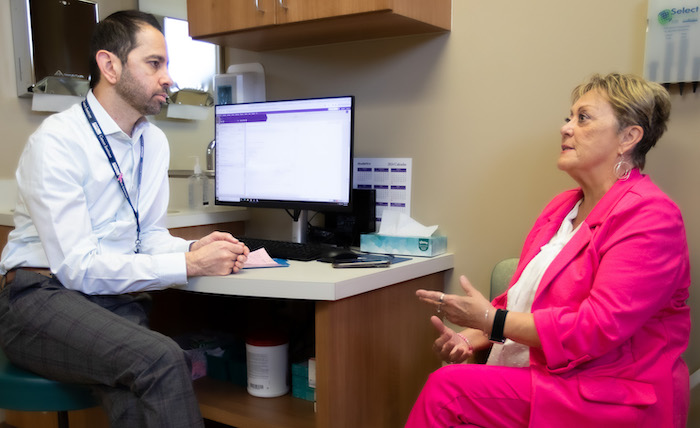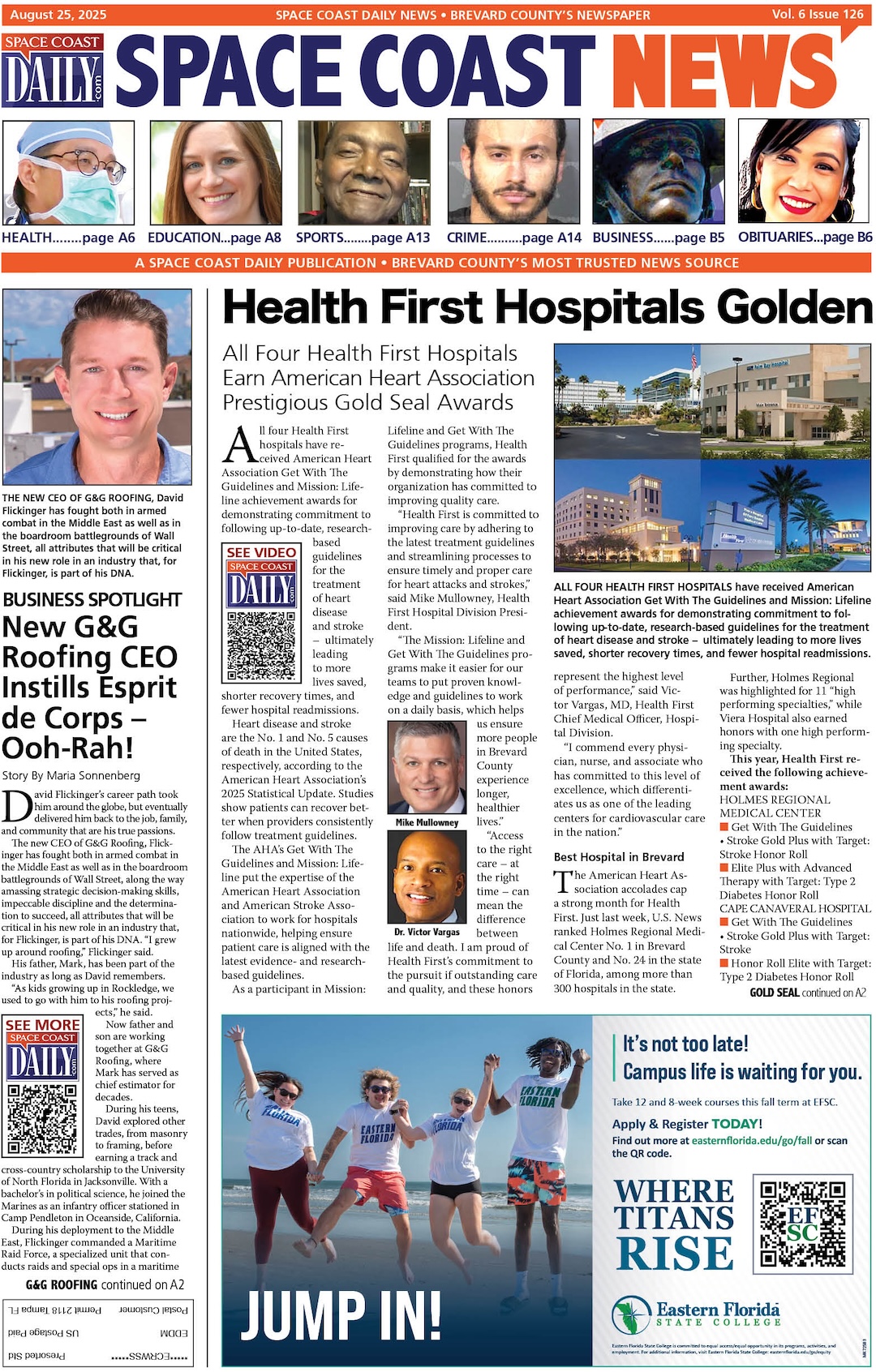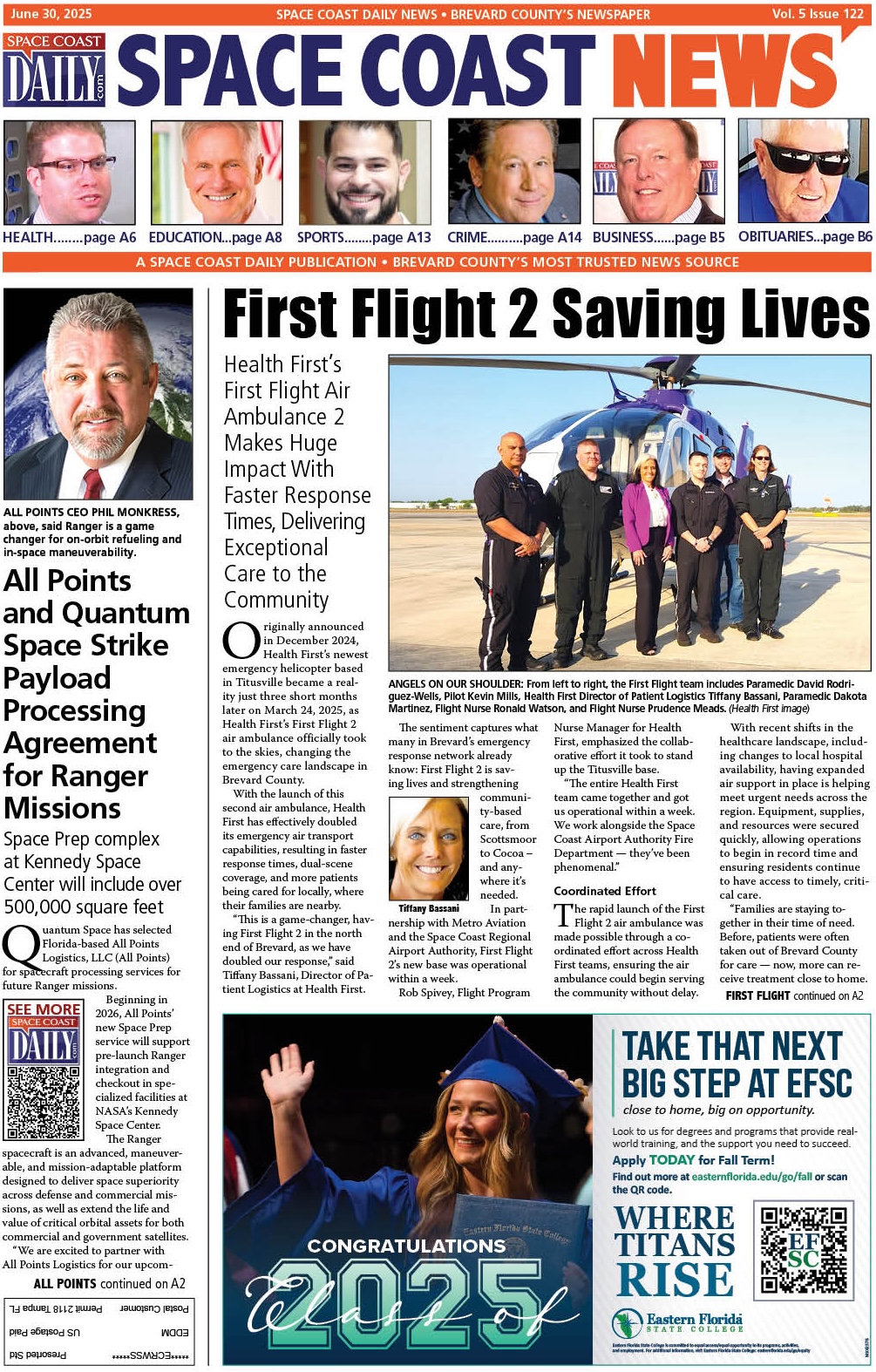MEDICAL SPOTLIGHT: Breast Cancer Patients May Now Enjoy Shorter Radiation Courses
By Space Coast Daily // March 26, 2024
Health First Cancer Institute in Viera patients ring BELL to mark the end of treatment

‘Radiation therapy is not what it was even five years ago.’ – Dr. Brendan Prendergast, Medical Director, Health First Radiation Oncology
BREVARD COUNTY, FLORIDA – The words a friend or acquaintance would use to describe Cathy Schmitt might include warm, happy, full of zest, larger than life. She needs all of those, because one thing a cancer diagnosis introduces is dread.
Schmitt’s diagnosis came in September. Ductal carcinoma in situ.
“I guess if you had to have breast cancer,” she reflects today, “this is a good one.”
Thus began a cancer journey that the mother of six girls describes with such breezy nonchalance that it’s important for the listener to pause on words like
“lumpectomy” and “radiation.”
“I almost feel guilty – I didn’t even want to ring the bell,” she said, referring to the bronze bell at the Health First Cancer Institute in Viera that patients ring to mark the end of treatment. “It wasn’t scary. This was nothing compared to what I was worried about.”

First To Sea, Then Lumpectomy
In late September, Schmitt had a consultation with Health First Breast Surgical Oncologist Mustafa Amani, MD. He reviewed her breast biopsy and delivered her cancer diagnosis.
“He was so calm. He was very reassuring,” Schmitt said. “It takes a special person to work with cancer patients. He has this way where I seriously didn’t even worry.”
In fact, when her surgery was scheduled and it conflicted with a three-week cruise she and her husband had purchased, she asked if she could postpone the surgery.
“Everyone on his team was amazing.”
Schmitt underwent an advanced lumpectomy procedure that utilized oncoplastic techniques during the surgical procedure to improve her cosmetic outcome. These include optimized incision placement and rearrangement of surrounding tissues to minimize postoperative distortions and improve appearance. The result is cancer removal that helps patients heal physically and emotionally.
Schmitt also had the benefit of SAVI SCOUT®, which uses radar technology for localizing the tissue meant to be removed. It’s a more precise method of localizing the tumor to increase the likelihood of complete removal.
“Everything turned out just as we wanted it to,” Dr. Amani said.

A Family History
Schmitt’s happy disposition belies a few searing cancer stories that involved close family members.
She lost a sister to cancer when she was just 38. It “was my first and probably my scariest experience as a caregiver.” About this same time, her mother was diagnosed with breast cancer. The result was a full mastectomy.
When Schmitt first heard her diagnosis in September, she thought this very well could be her experience.
“And instead, it was an outpatient procedure. I was home by the afternoon. And I can honestly say I experienced no pain.”
The other cancer story is her daughter’s. Her daughter was 21 when she was told she had Hodgkin lymphoma. She did rounds of chemotherapy – six months – that wiped her out. “She was pretty sick,” but it worked.
She got her life back, and over the next decade and more she made the most of it. She married, had one son, then another. Just months after her second arrived a new diagnosis was made: monophasic synovial sarcoma in her chest and lungs. In Dubuque, Iowa, where the family is from, “they didn’t even know what it was.”
She had surgery to remove it from her lungs and rounds of radiation therapy that left her unable to swallow. She tried all nontraditional treatments, but at the metastatic disease stages, the prognosis is poor. She died at 37 years old. She left behind a husband, a stepson, and sons 5 and 3 years old.
“It’s been seven years and three months,” Schmitt said. “That’s my big experience with cancer.”
Not Five Weeks of Radiation, Five Days
Schmitt’s breast surgery took place at Health First’s Viera Hospital. Around this time, Dr. Brendan Prendergast, Medical Director, Health First Radiation Oncology, ordered a sample from her biopsy sent to a lab to acquire its genomic signature. Comparing it to thousands of other patients with similar signatures, they were able to gauge the risk that it would return and spread. Schmitt’s risk came back low to moderate.
“Testing the patient’s own genomic signature from their tumor biopsy allows targeted, tailored therapy,” Dr. Prendergast said.
That, and the fact that Schmitt’s was a Stage 1 cancer, also offered her the option of accelerated partial breast radiation.
“When I started at Health First just 10 years ago,” the doctor told her, “every patient who had even a lumpectomy was getting five to six weeks of radiation, and to the whole breast. Now, we’re doing partial breast, and we’re doing it over five days. We’ve recognized we can do the same quality with less treatment. It’s a win-win.”
Schmitt described it as five visits of lying on the “couch” for 15 minutes listening to music while the TrueBeam device moves around her, delivering radiation therapy.
“She would come home in the same mood as she had when she left, and I liked that,” husband Kenny Schmitt said.
‘A Classic Case for Not Waiting’
“Sometimes I have guilt because my experience was absolutely nothing compared to people I love,” she told Dr. Prendergast at a recent visit. “I don’t feel like I even had cancer.”
“There are women in the community who are afraid to get their mammograms because they don’t want the ramifications of it,” Dr. Prendergast said. “Yours is a classic case for not waiting. If you wait, this treatment may not be available.”“We want to get the word out – radiation therapy is not what it was even five years ago,” he said. “It’s quick and effective, with minimal side effects.”
Advanced medical technology like the TrueBeam® radiotherapy system and SAVI SCOUT are made possible in part by philanthropic support from the community through the Health First Foundation. Learn more at HF.org/give.
To learn more about Health First Cancer Institute, visit HF.org/cancer, or call (321) 268-4200.













